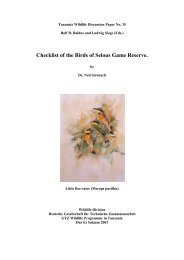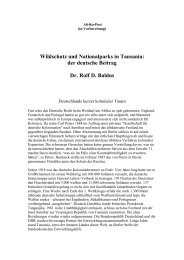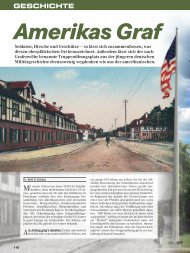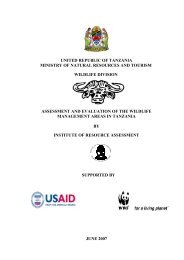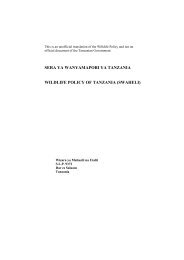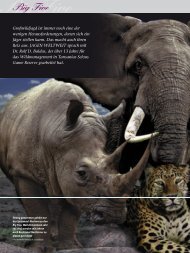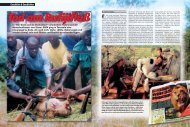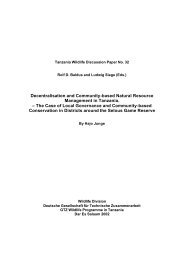African Indaba Articles - wildlife-baldus.com
African Indaba Articles - wildlife-baldus.com
African Indaba Articles - wildlife-baldus.com
You also want an ePaper? Increase the reach of your titles
YUMPU automatically turns print PDFs into web optimized ePapers that Google loves.
Conservation Hunting: People & Wildlife in Canada's NorthReviewed by Gerhard R DammThis booklet contains a number of interesting articles, many of them not only applicable to Canada’sNorth, but also in Africa. For those who participate in the discussions around hunting in South Africa, thecontributions of authors like William A Wall (A Framework Proposal for Conservation Hunting Best Practices),Jon Hutton (Exploitation and Conservation: Lessons from Southern Africa), Kai Wollscheid (MultilateralEnvironmental Agreements and the Future of Hunting), Lee Foote (Principles, Perspectives and Ethics ofConservation Hunting), Marco Festa-Bianchet (Trophy Hunting of Mountain Ungulates: Opportunities andPitfalls) are of great value.The booklet is actually a must-read for all who have the future of hunting in Africa at heart.Conservation hunting holds promise for improving the conditions of rural <strong>com</strong>munities, <strong>wildlife</strong> and habitat.This is the report of an international conference titled People, Wildlife and Hunting: EmergingConservation Paradigms held in Edmonton, Alberta, in October 2004. The conference brought togetherpeople sharing a <strong>com</strong>mon involvement or interest in conservation hunting (an outgrowth of recreationalhunting) that recognizes the significant contribution that hunting can make to social and ecological well being.This report focuses attention more particularly (but not exclusively) upon <strong>com</strong>munity-based conservationhuntingprograms operating in the Canadian North. Conference participants included hunters, outfitters,<strong>com</strong>munity representatives, <strong>wildlife</strong> managers, researchers and conservationists from across Canada andfrom overseas.The goal of the conference was to explore the relationship linking trophy hunting, <strong>wildlife</strong> conservation,and <strong>com</strong>munity sustainability in rural areas. Recognizing the importance of hunting to large-mammalmanagement and to <strong>com</strong>munity economies in many rural areas of Canada, and especially in the CanadianNorth, the Canadian Circumpolar Institute (CCI) and the Alberta Cooperative Conservation Research Unit(ACCRU) at the University of Alberta organized the People, Wildlife and Hunting: Emerging ConservationParadigms conference to foster greater awareness and understanding of this useful conservation tool.To obtain a copy of:Conservation Hunting – People and Wildlife in Canada’s North by Milton M.R.Freeman, Robert J. Hudson and Lee Foote (editors), 2005. Occasional Publication No. 56, CanadianCircumpolar Institute, Edmonton, Alberta. 112 pp, map, tables, illus. ISBN 1-896445-35-7. Can$15.00(plus S & H), contact Cindy Mason at:cindy.mason@ualberta.caWildlife Managementby Gerhard R DammAfrica’s <strong>wildlife</strong> within and outside formally protected areas is restricted to finite spaces by fences orhuman infrastructure. These restrictions threaten habitats or make them susceptible to change with thecausal factors being human-made. Consequently the management of habitats and the species within thesehabitats be<strong>com</strong>es a necessity. International agreements, national legislation, as well as public interest andpressure empower or restrict <strong>wildlife</strong> management.Traditional rigorous ecology and ethology do not guarantee effective conservation. The discipline ofconservation biology bridges the gap between the two fields and practical <strong>wildlife</strong> management; it marriesconservation concerns with socio-political, economic, administrative and managerial aspects. It creates thescientific base to respond under field conditions to data produced by scientists of varying branches. This isAdaptive Wildlife Management. The <strong>wildlife</strong> manager evaluates <strong>wildlife</strong> and its interactions within and withhabitats to determine management actions. He reviews and assesses its consequences on species,biodiversity and people. This reviewing process will lead either to a continuation or revision of actions.As an important step in getting <strong>wildlife</strong> management on an internationally recognized basis, the AddisAbaba Principles and Guidelines for Sustainable Use of Biodiversity (AAPG) outline that benefits derived63



